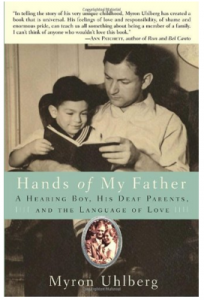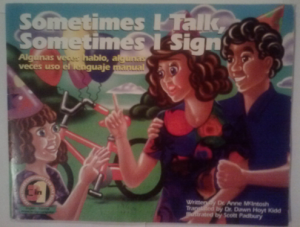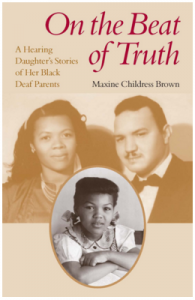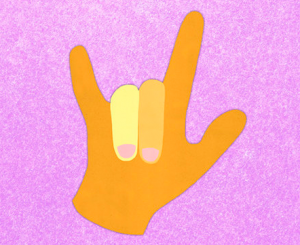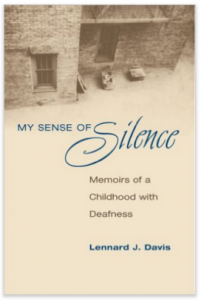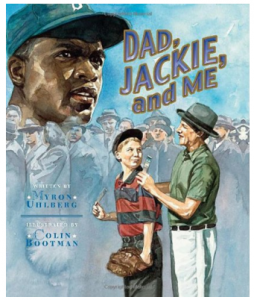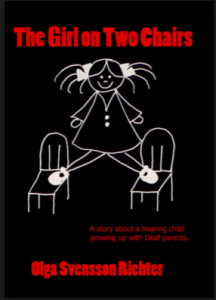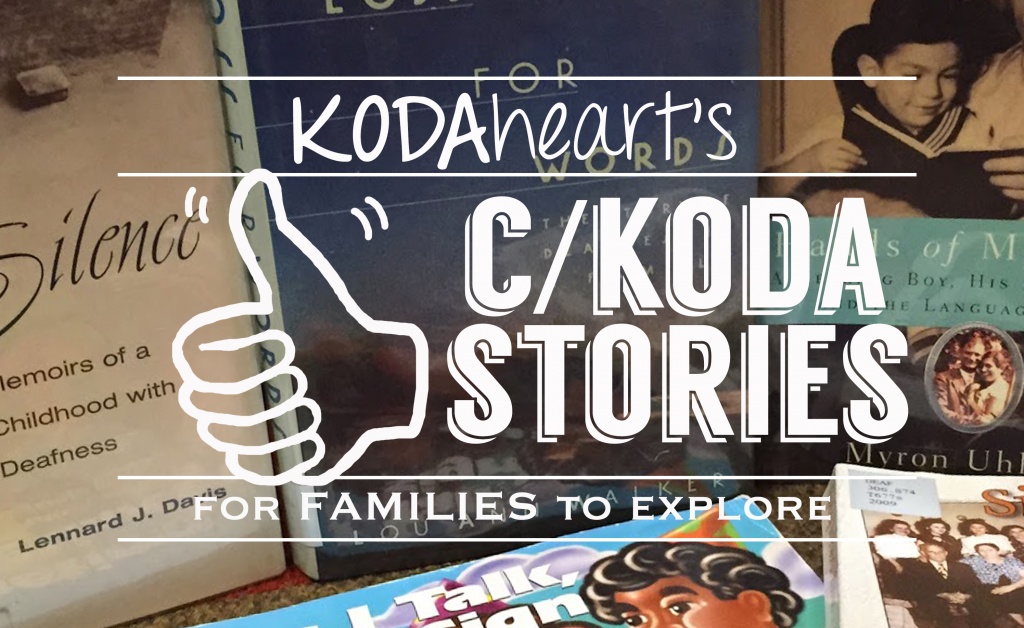
Autobiographies and other narratives provide a great opportunity to learn more about the complexity of the k/coda experience. These personal stories offer a unique glimpse into the day-to-day interactions between kodas and their parents, siblings, extended family members, and broader communities. They encourage reflection and discussion on the ways in which our families engage in language negotiation and cultural exchange. KODAheart has compiled a list of 10 stories that discuss the c/koda identity and we encourage your family to read and discuss the varied experience of life in hearing and deaf households.
As always, we encourage parents to preview these books before sharing them with their children. Autobiographical narratives often include topics from across their lives and some subjects may be too mature for young children. We have attempted to impose some order to these texts by suggesting an age range, but parents are urged to use their own discretion.
1. Hands of My Father by Myron Uhlberg
In this touching autobiography, Myron Uhlberg describes his upbringing in Brooklyn, New York. He offers profound insights on his parents, Louis and Sarah (both Deaf, Jewish, second-generation Americans from Russia and Hungary), and his younger brother, Irwin (who struggled with epilepsy) and a thriving Deaf community in the midst of the Great Depression. His recollections include touching stories of beach events at Coney Island with other Deaf families, visiting his father at the New York Daily News where Louis worked as a printer, and interpreting boxing matches on the family’s radio for his father and friends. Writing about a period before American Sign Language received linguistic recognition, and prior to the emergence of interpreting as a profession, Uhlberg’s book is filled with the tension and confusion of a young man trying to negotiate two very different cultural worlds.
This book is best shared with parents and children ages 13 and up.
2. Sometimes I Talk, Sometimes I Sign by Anne McIntosh
This children’s book tells the story of a koda, Sara Ana, as she prepares for a birthday party. Sara Ana is growing up in a multilingual and multicultural family- she has a deaf father and a hearing mother, and although the book does not explore the subject directly, the beautiful illustrations include symbols of her Latino heritage. Sara Ana’s story is told using three languages, English, Spanish and American Sign Language. Sometimes I Talk, Sometimes I Sign provides an opportunity for parents and young children to discuss linguistic differences and cultural experiences through a fun and lighthearted story.
This book is best shared with parents and children ages 3 and up.
3. On The Beat of Truth by Maxine Childress Brown
In this evocative autobiography, Maxine Childress Brown describes her upbringing in Washington, DC in the 1940s and 1950s. Growing up in the aftermath of WWII, amidst segregation, and before the passage of Civil Rights and Accessibility legislation, Brown provides an intimate look at the experiences of working class African Americans. Through her Deaf parents, Herbert and Thomasina, Brown and two younger sisters learned sign language and became a part of the local Deaf community. While the church and social clubs offered a place for community members to gather and offer support, Brown describes her home as the center of the African American Deaf community in Washington, DC. With detail and honesty from her position as observer, and frequently as interpreter, Brown describes the difficulties that faced her family and community, all the while still remembering their generosity and resiliency.
This book is best shared with parents and children ages 13 and up.
4. What It’s Like Growing Up in a Deaf Family by Lilit Marcus
This brief interview in Teen Vogue provides quick access to one aspect of the koda experience, the myriad questions asked by people outside of the deaf community. In a kind and direct manner, Lillit Marcus provides answers to questions like, “Can your parents drive?” and “How come you can hear?” while also providing insight on her family experience. Marcus addresses language, culture, and technology in her responses but also reinforces that all families are unique and deaf-hearing families are no exception.
This article is best shared with parents and children ages 8 and up.
5. Signing in Puerto Rican by Andrés Torres
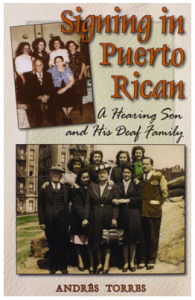 In Signing in Puerto-Rican Andrés Torres describes his experience as the only child of Deaf Puerto Rican migrants, Andrés and Bienvenida, in New York City during the 1950s and 1960s. He was often at the center of a large extended family, both deaf and hearing, that blended Spanish, English, and sign language as well as Puerto Rican and American cultures. In this book Torres provides intimate access to the Puerto Rican Deaf community in New York, revealing a dynamic religious and social networks that gathered at Catholic Deaf events and in his family home. Torres’s stories are colored by the events of the Civil RIghts Movements and the Vietnam War as he recalls the profound impact of these historical events on the city, his family, and himself.
In Signing in Puerto-Rican Andrés Torres describes his experience as the only child of Deaf Puerto Rican migrants, Andrés and Bienvenida, in New York City during the 1950s and 1960s. He was often at the center of a large extended family, both deaf and hearing, that blended Spanish, English, and sign language as well as Puerto Rican and American cultures. In this book Torres provides intimate access to the Puerto Rican Deaf community in New York, revealing a dynamic religious and social networks that gathered at Catholic Deaf events and in his family home. Torres’s stories are colored by the events of the Civil RIghts Movements and the Vietnam War as he recalls the profound impact of these historical events on the city, his family, and himself.
This book is best shared with parents and children ages 13 and up.
6. My Sense of Silence by Lennard Davis
In this honest memoir, Lennard Davis offers piercing insight into the complexities of growing up in a Deaf and hearing family. Written as an adult, Davis recounts his impoverished upbringing in the Bronx during the 1950s and 1960s. His insights focus on his relationships with his parents, Jewish English immigrants, Morris and Eva, his older brother, Gerald, and a broader Deaf community in the city. Davis’s writing expresses the confusion and complexity of cultural and linguistic conflict, during a period of great cultural tumult, before the linguistic and cultural recognition of the American Deaf community. Although frequently sharp in his criticism, Davis emphasizes the contested position of k/codas who struggle to reconcile precious and private moments between family members with broader social attitudes regarding deafness and disability.
This book is best shared with parents and children ages 13 and up.
7. Shelly’s Outdoor Adventure by Kentrell Martin
This children’s book is part of an interactive series starring Shelly, a young koda that teaches her friends sign language while going on adventures. In this book, Shelly takes a walk outdoors, learning about the environment and weather. Each page includes English and American Sign Language terms for the features that Shelly identifies. The Shelly’s Adventures series provides parents and signing children with a story that reflects the bilingual or multilingual worlds in which they live.
This book is best shared with parents and children ages 3 and up.
8. A Loss for Words by Lou Ann Walker
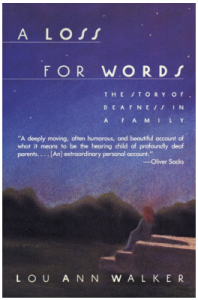 Lou Ann Walker’s classic memoir, A Loss for Words, provides a personal look at life as a koda growing up in Indiana. Her parents, involved in a number of local and national Deaf organizations, exposed their daughters (Lou Ann, Kay, and Jan) to a vibrant, signing, midwest Deaf community in the 1950s and 1960s. Walker’s writing provides profound insights on moving between hearing environments (at school and with non-signing family members) and deaf environments (at home and at deaf events), exploring the ways in which kodas and codas struggle to make sense of their position in the community.
Lou Ann Walker’s classic memoir, A Loss for Words, provides a personal look at life as a koda growing up in Indiana. Her parents, involved in a number of local and national Deaf organizations, exposed their daughters (Lou Ann, Kay, and Jan) to a vibrant, signing, midwest Deaf community in the 1950s and 1960s. Walker’s writing provides profound insights on moving between hearing environments (at school and with non-signing family members) and deaf environments (at home and at deaf events), exploring the ways in which kodas and codas struggle to make sense of their position in the community.
This book is best shared with parents and children ages 13 and up.
9. Dad, Jackie, & Me by Myron Uhlberg
In this nostalgic and semi-autobiographical children’s book, Myron Uhlberg tells the story of a young koda and his deaf father caught up, like most residents of Brooklyn in the summer of 1947, in the winning season of the Brooklyn Dodgers. Father and son closely followed the rookie season of Jackie Robinson, the first African American professional baseball player, using newspaper articles and radio broadcasts to share in the excitement. Beautiful and nuanced, this book captures the enthusiasm of the period while also illustrating deeply personal elements of the koda experience.
This book is best shared with parents and children ages 5 and up.
10. The Girl on Two Chairs by Olga Svensson Richter
Olga Svensson Richter’s work, The Girl on Two Chairs, reflects the way that the experience of growing up within a deaf-hearing family transcends language, culture, and geography. In this autobiography Richter provides a compelling narrative of her upbringing in Sweden during the 1950s and 1960s. She was raised by Deaf parents using Swedish Sign Language (Svenskt Teckenspråk). Her lighthearted story highlights the challenges of identity development for a girl who stands “on two chairs” and between two linguistic and cultural worlds. With nuance, she describes the struggle for access and recognition of the Swedish Deaf community.
This book is best shared with parents and children ages 13 and up.
This list is just the beginning of all of the various c/koda stories available. For even more great reads, check out our resource page. If you have additional c/koda books to recommend, please share them with us on facebook, twitter or instagram and we will add them to our future lists!
[Images courtesy of Amazon.com]
